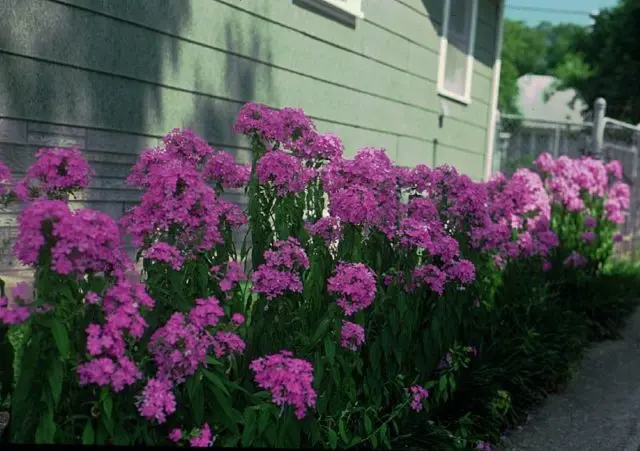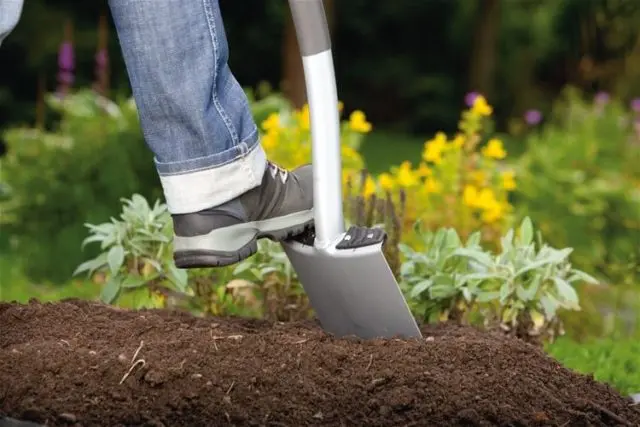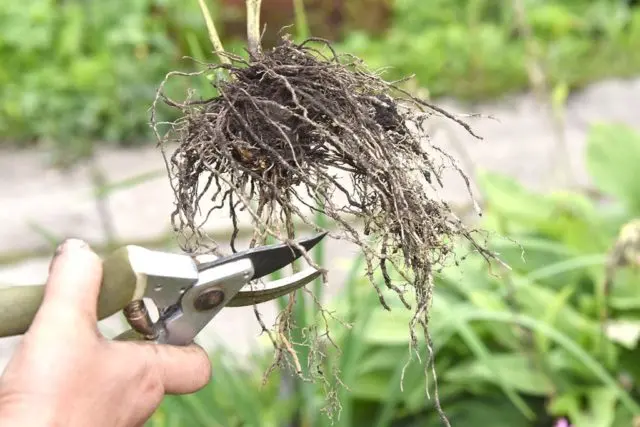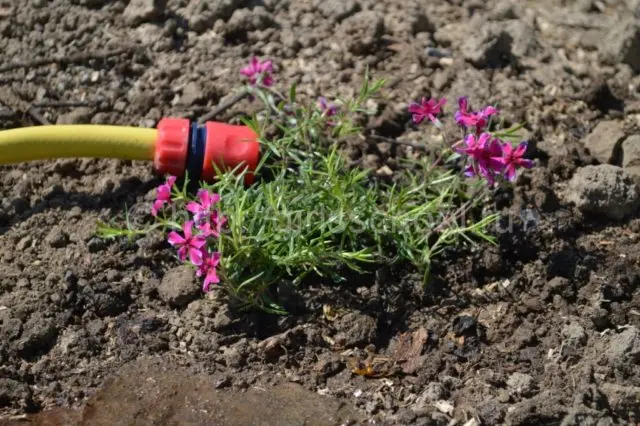Contents
Perennial phloxes, which have many varieties and colors, wonderfully decorate the backyard. However, it is not recommended to grow them in one place for a long time, as they gradually lose their decorative effect. In this case, transplanting phloxes to another place helps. In addition, flowers may need to change the site for various reasons.
Goals and objectives of phlox transplantation
It has been noticed that with constant cultivation in the same place, some perennials, including phloxes, gradually begin to feel worse and worse. Their growth slows down, flowering occurs with a delay, and the buds themselves lose their bright colors and become more faded and inconspicuous. This is due to the fact that the soil is gradually depleted, it accumulates harmful substances and pathogens that adversely affect plant health. However, if you change the landing site, the decorativeness of the flowers is quickly restored.

Periodically, phloxes need to be transplanted to a new place.
There are other reasons why you have to transplant phloxes to another place in the fall or spring. Here is some of them:
- The need to free up space in the garden. The site on which phloxes grow is required for planting other plants, laying communications, and construction.
- Various weather disasters, as a result of which a plot with flowers can be, for example, flooded.
- Selling a garden or house, moving to a new location, while the old owner wants to keep the flowers for himself.
- As a result of construction or other work near the site, the conditions for phlox became unsuitable (the place turned out to be in the shade, the groundwater level rose too much, etc.).
- The threat of pests or diseases.
After how many years should phlox be transplanted
It is believed that in one place phlox can grow up to 10 years. However, this is the deadline for the flowers to completely degenerate. Flower growers prefer to transplant them to a new place every 5-6 years, there are also recommendations to do this once every 1 years. You need to navigate this issue by the state of the flowers. If the soil is fertile enough and well suited for phlox, then the interval between transplants can be slightly increased.
When are perennial phlox transplanted?
It is best to transplant perennials while they are at rest, before the start of the growing season and after it ends. In this case, the plant will get off with minimal stress and quickly recover in a new place. During the growing season, you do not need to touch the phlox. Even if a transplant made during this period is successful, the adaptation of plants in a new place can take a long time, while the risk of their death increases many times over.
When is the best time to transplant phlox: in spring or autumn
There is no consensus among gardeners about when phlox should be transplanted, in autumn or spring. This is due to the fact that different regions have their own climatic features. For example, in areas with an early onset of winter, it is better to transplant in the spring, since in the fall there is a high risk that the plant will not have time to take root in a new place and die in the winter. If the climate of the region is warm enough, and winter comes late, then phloxes can be transplanted to another place in the fall.

If necessary, phloxes can be transplanted even in summer
When is the best time to repot phlox in spring?
When transplanting phloxes in the spring, gardeners usually focus not on a calendar date, but on the timing of the arrival of this spring. Work should begin when the ground is completely thawed, but the plant has not yet begun to grow. In central Our Country, this time usually falls on the second half of April, and sometimes at the beginning of May.
Is it possible to transplant phloxes in summer
Transplanting flowers in the summer is most often a necessary measure, so in normal circumstances it is best to try to avoid it. If there is no alternative, then plants should be transplanted subject to the following requirements:
- Transplantation is carried out only with a large clod of earth on the roots.
- It is impossible to divide the bush at this time.
- All work is performed only in cloudy weather in the evening.
- Bush pruning is not performed.
Practice shows that even if all these conditions are met, the risk of flower death after a summer transplant remains high. Therefore, the first time the plants need quality care.
When to transplant phlox in the fall
The best time to transplant phlox in the fall to another place is the beginning of September or even the end of August. In this case, the plants have enough time to take root well in a new place, adapt to the conditions and prepare for wintering. With a later work, the risk of an unsuccessful outcome increases significantly, therefore, phloxes can be transplanted in October only in the southern regions.
When to transplant phloxes in the suburbs
The region near Moscow does not have a stable climate. Spring comes here quite late, the snow cover lasts for a long time and completely disappears at the end of April, and sometimes at the beginning of May. It is at this time that it is recommended to transplant phloxes. If time is lost, then you can do this in the last days of August or at the beginning of September. The early arrival of winter happens quite rarely in the Moscow region, so there is enough time for plants to get used to a new place and prepare for winter.
When phloxes are transplanted in Siberia
The early arrival of winter makes it impossible to transplant phlox in autumn in Siberia. Frosts in some areas of this region can begin as early as September, so all work is carried out in the spring, after the ground has thawed and the threat of return frosts has passed.
Do I need to cut phlox when transplanting?
Phlox pruning is carried out annually, regardless of the transplant. This procedure has a positive effect on the health of the plant, relieves it of old and dry shoots, and promotes the formation of young strong shoots. Pruning is carried out after the end of flowering, in late August or early September, i.e. at the same time as the autumn transplant. Therefore, these works are often combined.

Before transplanting, phloxes are cut
The absence of green mass allows the bush to direct all its forces to the growth of the root system.
How to transplant phlox correctly
In order to properly transplant phloxes, you need not only to choose the right time, but also to carry out preparatory work, perform the transplantation itself with high quality and accuracy and provide the plant with the necessary care after the work.
Site selection and soil preparation
Phloxes love sunlight, so the site for their landing should be well lit. In the shade, the plants are strongly drawn out, while the flowers lose their brightness and saturation. It is desirable that the sunlight is not direct, diffused, so it is better to plant them not in open areas, but next to a fence, wall of a building or structure. This will further protect them from the cold wind. At the same time, the neighborhood with large trees and shrubs is undesirable, since moisture-loving phloxes will constantly lack water next to them.

Phloxes feel great near the fence or against the wall of the house.
The soil for these flowers needs loose and fertile, with a high content of peat and sand, while its acidity should be close to neutral. If the earth is too acidic, then dolomite flour, chalk or lime must be added to it.
The place of the future landing must be cleaned of weeds in advance and dug up by adding granular mineral fertilizer or organic matter, for example, rotted manure or humus. If the transplant is carried out in the spring, then it is better to add nitrogen-containing top dressing to the soil: urea, nitrophoska, ammonium nitrate. During autumn transplantation, nitrogen fertilizers are not applied so as not to provoke the growth of shoots, it will be enough to add a little phosphorus and potassium mineral complexes to the soil. It is also useful to use wood ash to improve soil characteristics by adding it at the rate of 1 cup per 1 sq. m. of landing area.

The site for planting phlox is better to dig in advance
You can immediately prepare planting pits for transplanted bushes, their depth should be at least 0,3 m. A distance of at least 0,5 m should be left between adjacent flowers, and if the variety is tall, then the interval can be increased to 0,6 m.
How to dig and prepare bushes
Before extracting a phlox bush, the soil under it must be watered abundantly. This will help keep the earth ball on the roots of the plant. It is best to dig up a bush with a pitchfork, so there is less chance of damaging the numerous horizontal roots of the plant. If you use a shovel, then it is advisable to make an earthen ball a little larger. The plant is gradually dug in a circle, and then carefully pulled out of the ground.
Algorithm for transplanting perennial phloxes
The extracted flower is inspected, the roots are shortened to 15-20 cm. If the bush is old enough and branched, then it can be divided into several parts, each of which should contain 4-5 shoots with its own root system.

Roots that are too long need to be trimmed
The resulting delenki are immediately planted in planting pits, which should be spilled with water in advance. The bush is placed in the center and gradually falls asleep, while deepening the root neck by about 5 cm. After the pit is completely covered, the root zone is compacted, watered abundantly with water and mulched to maintain moisture in the soil.
Phlox care after transplant
After transplanting, phlox requires regular watering. This must be monitored and not allowed to dry out the root zone. If there is a sufficient amount of precipitation, then the frequency of irrigation should be reduced, and if necessary, artificial soil moistening can be completely abandoned. An excess of water will not benefit the flowers. Mulch the root zone with rotten manure with straw, peat and humus. Gradually decomposing, such mulch perfectly enriches the soil with nutrients.

After transplanting, phloxes need regular watering.
You should constantly pay attention to the condition of the bush as a whole. If any of the shoots wilt, then it must be cut out immediately so that it does not become a source of disease or a breeding ground for pests. Further care for transplanted phlox is carried out as planned, depending on the time of year.
Conclusion
Transplanting phlox to another place is a simple procedure, it does not require special training and special knowledge. It is enough to know the general rules for the work, observe the deadlines and be guided by the recommendations. If everything is done correctly, then phloxes will transfer the transplant without any problems and will delight the gardener with abundant flowering for a long time.









